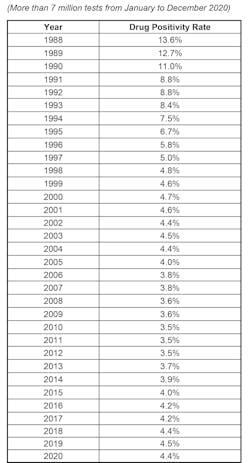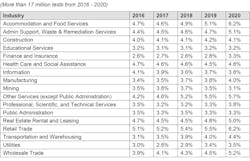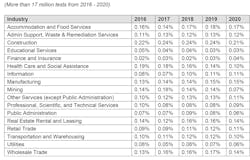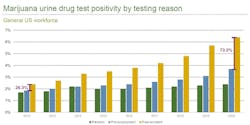Drug usage among construction workers may be lower than the U.S. workforce average, yet that group appears to be following a growing labor force trend to wider marijuana usage while also maintaining a very isolated, but comparatively outsized appetite for cocaine and methamphetamine.
That’s what a new Quest Diagnostics study Quest Diagnostics: Drug Testing Index on its latest drug testing results hints at about the construction sector, providing some reassurance that, while disconcerting, that industry’s worker drug usage issues aren’t particularly unusual or far out of line with those of other sectors in the economy.
With results from some 7 million drug tests it did for employers in 2020, those in what Quest labels the “combined U.S. workforce” — which includes the “Federally (Testing) Mandated, Safety-Sensitive Workforce” and the “General U.S. Workforce” — Quest found about 4.4% of the urine tests came back positive for at least one drug on the panel (Table 1).
That was roughly in line with findings from 2019 when a 16-year high in positivity was reached. Of 17 industry sectors separated out, construction (which includes electrical contractors) fell roughly in the middle of results for the smaller general workforce group with a 4.1% positivity rate (Table 2), lower than the combined group rate of 5.5 — up from 5.3% in 2019 (Table 3).
Marijuana positivity in construction in 2020 came in at 2.5% (Table 2, Industry DTI Tables word doc), the highest rate in five years for the sector and up from 2.2% in 2019. Eight industry sectors registered a higher number, while eight were lower; the range was 0.79% to 6.3%. However, construction’s rate was lower than that for the general U.S. workforce. Out of approximately 5 million urine tests performed, 3.6% were positive for marijuana (Table 4). That, too, was a five-year high.
For the fifth year in a row, construction came in with the highest percentage of cocaine positives among industry groups, at 0.32% (Table 5).
That was higher than the total for some 5 million tests across the general workforce: 0.22% (Table 6).
One of the big takeaways from the new testing numbers, Quest says, is the steady growth in positivity for marijuana and what that means for employers, most of whom are committed to maintaining a drug-free workplace, and use testing as a means of compliance and enforcement. But as more states decriminalize marijuana and society becomes more accepting of it, employers who have zero-tolerance policies for the drug in place might have to follow suit. Yet any headlong rush to dismantle them would have to rationalize the stubborn issue of impairment stemming from marijuana usage — how to define it, reliably test for it, and craft safe-workplace employment policies around those measures. Even without that, any presumption of impairment might be sufficient to keep hard employer restrictions in place.
“None of these decriminalization laws being passed in states permit someone to work while impaired or use it on company premises,” says Barry Sample, Ph.D., Quest Diagnostics’ senior director of science and technology. “Though there’s no breathalyzer test for marijuana like there is for alcohol, marijuana can be impairing. And while no drug test can tell you whether someone is impaired at the time of the test, a positive does raise the level of suspicion and could be indicative of a pattern of usage.”
Nevertheless, Sample says, there are signs that employers in states that have passed recreational marijuana laws are beginning to step back from including marijuana in their drug tests.
“We’re seeing quite a range of change in employer behavior on how panels are constructed,” he says. “In Nevada, for instance, we’ve seen about an 8% decline recently in the use of marijuana panels.”
But testing data suggest employers might want to tread carefully. Quest says data seem to indicate that marijuana usage might have a link to workplace accidents. In 2020, pre-employment test positivity was 3.7%, while the post-accident rate was 6.4% — a 73% spread. In 2012, well before the marijuana legalization push began, the spread was 26%: 1.9% vs. 2.4% (see Chart below).
Sharper growth of post-accident marijuana positives than pre-employment positives hints that more permissive attitudes about pot have led to more usage and possibly more impairment, which could be playing a role in accidents.
“While urine drug testing cannot determine whether an individual is under the influence or impaired at the time of test, our post-accident data suggests that marijuana use may play a role in those workplace incidents, prompting a drug test," Sample says.
Tom Zind is a freelance writer based in Lees Summit, Mo. He can be reached at [email protected].
About the Author
Tom Zind
Freelance Writer
Zind is a freelance writer based in Lee’s Summit, Mo. He can be reached at [email protected].








